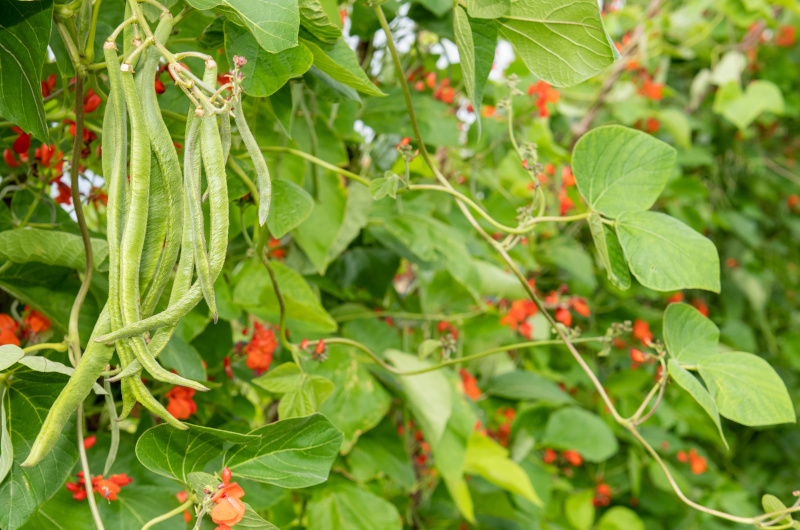How To Grow Runner Beans
Runner beans are a beloved and popular vegetable in British gardens. Known for their vibrant flowers and tasty pods, growing runner beans is a rewarding experience for gardeners of all levels. In this guide, we’ll walk you through the steps to successfully cultivate runner beans in your own garden, from preparing the soil to harvesting a bountiful crop.
Choosing the Perfect Spot:
Selecting an ideal location is crucial for growing runner beans. Look for a sunny spot in your garden that receives at least six hours of sunlight daily. Runner beans thrive in warmth, so choose a sheltered area if possible, as strong winds can damage their delicate vines.
Preparing the Soil:
Prepare the soil well in advance to ensure optimal growing conditions for your runner beans. Start by removing any weeds or debris from the planting area. Runner beans prefer a slightly acidic soil with a pH between 6.0 and 6.8. Test your soil using a pH testing kit and make adjustments accordingly. Dig the soil to a depth of around 12 inches (30 cm) and incorporate plenty of well-rotted organic matter, such as garden compost or manure, to improve fertility and moisture retention. Some gardeners, particularly the older generations like to dig a trench in late summer or autumn, filling it with green kitchen waste, shredded paper, or grass cuttings. The trench is then filled in and left to decompose over the winter. By early summer, the trench contents will have started to break down, releasing nitrogen and other nutrients to the hungry bean plants. The roots of the bean plants will fix nitrogen, benefitting not only the bean crop, but also successive plantings in the following year.
Sowing Runner Bean Seeds:
In the UK, it’s advisable to start sowing runner bean seeds indoors in late April or early May. Fill seed trays or individual pots with seed compost and place one or two seeds in each container, ensuring they are sown at a depth of approximately 2 inches (5 cm). Keep the containers in a greenhouse or on a sunny windowsill until the risk of frost has passed. Alternatively, you can sow the seeds directly outdoors from mid-May to June, when the soil has warmed up. Plant the seeds at a depth of 2 inches (5 cm) and space them 8 inches (20 cm) apart in rows that are approximately 18 inches (45 cm) apart.
Providing Adequate Support:
As climbing plants, runner beans require sturdy support to grow and thrive. Before planting the seeds, erect a trellis, wigwam, or row of poles in the ground. Ensure the support structure is at least 6 feet (2 meters) tall to accommodate the beans’ vigorous growth. When the seedlings have reached a height of 6 inches (15 cm), carefully transplant them to their final position, taking care not to disturb the roots. Secure the plants to the support system using twine or garden ties.
Watering and Maintenance:
Runner beans have a high water requirement, so it’s essential to provide them with consistent moisture. Water the plants regularly, especially during dry spells, ensuring the soil remains consistently moist but not waterlogged. Applying a layer of organic mulch around the base of the plants will help retain moisture and suppress weeds. Regularly check for any signs of pests or diseases, such as aphids or slugs, and take appropriate action promptly.
Protecting Against Pests and Diseases:
Runner beans can be vulnerable to pests and diseases, which can hinder their growth and productivity. Monitor your plants regularly, checking both the leaves and the pods. If you spot any signs of infestation, consider using organic pest control methods, such as introducing beneficial insects or applying natural sprays. Practicing good garden hygiene, including removing fallen foliage and debris, can also help prevent disease.
Harvesting and Enjoying the Bounty:
Runner beans are ready to be harvested when the pods reach a length of 8 to 12 inches (20 to 30 cm). The pods should be firm and snap easily when bent. To harvest, use a pair of scissors or your fingers, taking care not to damage the plant. Regularly picking the pods encourages more production. Enjoy your freshly harvested runner beans by steaming, boiling, stir-frying, or adding them to your favorite recipes.
After Cropping:
Once the plants start to die back, cut the plants off at ground level, rather than pulling them up. Like all beans, runners have bacteria in nodules on their roots which help to fix nitrogen. Leaving the roots in the ground means valuable nitrogen will stay in the soil, benefitting the next crop planted in the same spot. In a traditional 4 crop rotation, brassicas generally follow legumes, and their leafy, green crop benefits greatly from this boost in soil nitrogen levels.
Growing runner beans in your garden can provide you with a delicious and nutritious crop that is truly British. By following these steps and providing the necessary care and attention, you’ll be rewarded with a bountiful harvest of runner beans to enjoy throughout the summer months. Get started today and experience the joy of cultivating this classic vegetable in your own backyard. Happy gardening!



